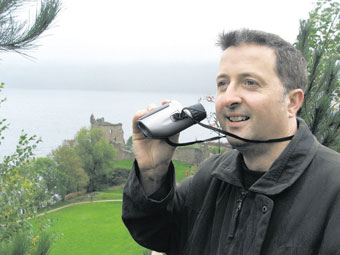
November 6, 2006
As a Scot living in self-imposed exile in Canada, the memories of Scotland are always in the periphery of my thoughts. I have wonderful memories of the Highlands and the wondrous landscapes I have laid my eyes upon.
I am particularly fond of the great Great Glen and its spectacular beauty and am always concerned about the tourism that occurs around Loch Ness and how it might adversely affect this magnificent body of water.
I recently came across this article from the Highland News that pleases me to no end that Scotland’s most famous possible cryptid haunt is benefiting from new water purity measures:
Monster spotter applauds £2m Ness clean-up
By Claire Doughty
Published: 02 November, 2006
NESSIE will have clearer water to swim in after millions of pounds was invested in cleaning up her ‘home’.
And, it is hoped, the improvements to the Loch Ness Monster’s surroundings will lead to more sightings.
Scottish Water have just completed two projects worth over £2 million in the world famous stretch of water.
Modern waste water treatment works have been installed at Foyers on the south shore of the loch, and at Balnain, near Drumnadrochit, on the north shore.
Both works discharge a cleaner effluent into the rivers Foyers and Enrick, which flow into Nessie’s abode.
Gary Campbell, president of The Official Loch Ness Monster Fan Club, welcomed the news.
He said: ‘It is great to see this improvement in the quality of Nessie’s habitat. There have only been a few sightings this year and I’m sure that cleaner water will mean Nessie is seen more often.
‘Seriously, this is good news for the many Nessie hunters who visit the area. A cleaner environment will encourage them to return.’

Nessie fan club president Gary Campbell is hopeful the cleaner water will make for more sightings.
Sheila Campbell-Lloyd, Scottish Water’s regional manager in the Highlands, added: ‘This is a brilliant example of Scottish Water investing to ensure that the Highlands remains a great place to live and visit. A cleaner environment makes for a better experience and that in turn should benefit the important tourist trade in the area.’
The £1.8 million treatment works located in Lower Foyers, near the lochside, has two septic tanks and filters which provide secondary treatment, which separates solid and liquid waste and is filtered down to produce a high quality effluent.
It replaces a number of outdated septic tanks around Lower and Upper Foyers. By reducing the number of discharges to just one, the environment is now much more pleasant and the river and the loch are now much cleaner. At Balnain, the £300,000 project involves a new septic tank and reed bed system which protects the environment and boosts the water quality in the River Enrick.
Scottish Water says reed beds use natural methods to break down sewage and recycle it into clean water. They don’t use any chemicals and reduce the risk of flooding, minimise odours, blend in well with the environment and provide habitats for wildlife.
The most recent Nessie sighting was last month when a young English couple holidaying in the Highlands claimed they encountered Nessie twice during their stay. Nick Thurston and his fiance Emma Louise Jones won a holiday to the Highland capital and spotted the monster whilst on a cruise. Their second sighting was a week later whilst driving near to Urquhart Castle.
Some years ago a major effort was made to clean up Okanagan Lake which was being polluted by Eurasian Millfoil and human waste. When new sewage facilities were put in and the millfoil dealt with, sightings of Ogopogo did seem to increase. I wonder if this will happen at Loch Ness too.
We’ll keep an eye peeled for any interesting developments and report them here.
About John Kirk
One of the founders of the BCSCC, John Kirk has enjoyed a varied and exciting career path. Both a print and broadcast journalist, John Kirk has in recent years been at the forefront of much of the BCSCC’s expeditions, investigations and publishing. John has been particularly interested in the phenomenon of unknown aquatic cryptids around the world and is the author of In the Domain of the Lake Monsters (Key Porter Books, 1998).
In addition to his interest in freshwater cryptids, John has been keenly interested in investigating the possible existence of sasquatch and other bipedal hominids of the world, and in particular, the Yeren of China. John is also chairman of the Crypto Safari organization, which specializes in sending teams of investigators to remote parts of the world to search for animals as yet unidentified by science. John travelled with a Crypto Safari team to Cameroon and northern Republic of Congo to interview witnesses among the Baka pygmies and Bantu bushmen who have sighted a large unknown animal that bears more than a superficial resemblance to a dinosaur.
Since 1996, John Kirk has been editor and publisher of the BCSCC Quarterly which is the flagship publication of the BCSCC. In demand at conferences, seminars, lectures and on television and radio programs, John has spoken all over North America and has appeared in programs on NBC, ABC, CBS, PBS, TLC, Discovery, CBC, CTV and the BBC.
In his personal life John spends much time studying the histories of Scottish Clans and is himself the president of the Clan Kirk Society. John is also an avid soccer enthusiast and player.
Filed under Cryptid Universe, Cryptotourism, Cryptozoology, Eyewitness Accounts, Lake Monsters, Loch Ness Monster, Public Forum, Sea Serpents